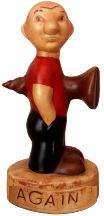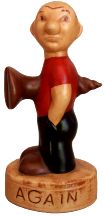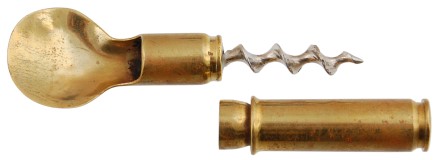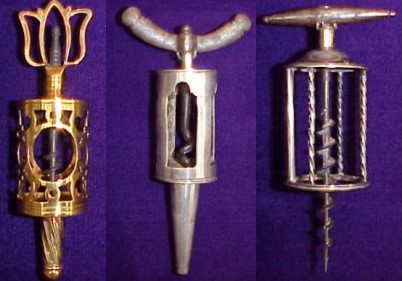 |
 The Virtual Corkscrew Museum's Weekly Newspaper |
 |
 |
 The Virtual Corkscrew Museum's Weekly Newspaper |
 |
|
Sunday, May 10, 2009 |
Number 556 |
Parr and Goodyear
In the August 3, 2008 issue, we published a story about Parr's Patent. This article appeared in the August 3, 1861 issue of the Scientific American:
Improved Camp Chest. The two accompanying engravings are pictures of the same thing, though one represents it as a table spread with a cloth, set with dishes, and supplied with seats for three persons, while in the other it appears as a moderate-sized box or chest. Though the chest is only 31 inches in length, 14 in width, and 10 in depth, and weighs but 40 lbs., it contains the following articles: 3 web-seat camp stools, made of the best hickory, and folded together; hatchet, saw, carving knife and fork, 3 flasks, that will, in the aggregate, hold one gallon; tea caddy, coffee caddy, wash bowl, dipper, 8 plates, 4 knives and forks, 4 each of table and teaspoons, tea and coffee pot combined, with a strainer; frying pan, pot for boiling, 3 drinking cups, sugar and milk bowl, cruet stand for pepper, salt, mustard and vinegar, with mustard spoon and cork screw combined; 1 apparatus for boiling tea or coffee, and fuel for 20 meals; 2 table cloths, and 2 towels.
The principal novelty of this invention consists in the arrangement for securing the legs to the box in such manner that they will fold snugly inside to close the box, and will support it firmly when it is used as a table. The legs are attached to the inside of the box by the hinges so that when the box is opened the legs can be turned down to support it as a table. The latch upon the side of each leg, can be turned down into the notch thus holding the leg very firmly in place.
This camp chest is not intended for soldiers, merely, but will be found quite as well adapted to the use of hunters, fishers, picnic parties, and excursionists generally.
We are informed that is has been examined by President Lincoln, ex-President Fillmore, Gen. Mansfield, Gen. Miegs and other competent authorities, who have given it their fullest endorsements.
Mr. Parr, who seems to be fertile in getting up convenient things, has also invented a canteen case, which, like the camp chest, has a cruet stand for pepper, salt, vinegar and mustard; mustard spoon and corkscrew combined, knife and fork, spoon, tea caddy, drinking cup, apparatus for boiling tea and coffee, with fuel sufficient for 20 meals. This light, convenient and useful article is inclosed in a leather case, nicely finished, and is designed to be suspended from the shoulder by a leather strap in the same manner as a cartridge box.
Altogether, these arrangements of Mr. Parr are unique and useful, and as such we can recommend them to the soldiers of our army.
The patent for this invention was granted June 25, 1861; and further information in relation to it may be obtained by addressing the inventor, George Parr, at Buffalo, N. Y.
Although the Scientific American article alludes to a "mustard spoon and cork screw combined", Parr's patent description is "... containing vinegar, salt, pepper, mustard, cork screw and mustard spoon, as marked in the drawings". The corkscrew drawing shows what is apparently a Goodyear corkscrew*.
*On May 6, 1851, Nelson Goodyear was granted U. S. Patent No. 8,075 for his "Improvement in the Manufacture of India-Rubber." The patent details the process but does not specify a corkscrew or any of the other products manufactured of India Rubber. However, the roundlet corkscrew can be found with the marking GOODYEARS PATENT 1851. Goodyear extended his patent in 1865 to an expiration date of May 6, 1872.

GOODYEARS PATENT 1851 mark on roundlet
________________________________

Combination mustard spoon and corkscrew?
French Cage - M. Pein

Cage Corkscrews*
The Technical Repository; containing Practical Information on the subjects connected with Discoveries and Improvements in the Useful Arts by Thomas Gill was published in several volumes. In an 1825 issue there is a chapter entitled "On the Manufacture of Superior Cutlery in France."
In 1820, M. Pein explained his mode of manufacturing them (scissors) to the Society of Encouragement ... Rasps, penknives, pincers, steels to sharpen knives upon, corkscrews, and a thousand other small instruments, are also the workmanship of the cutler. He also manufactures a kind of corkscrew called à-cage, which is extremely convenient: it is formed of a common corkscrew, enclosed in a kind of cage. The screw of the corkscrew is furnished with a kind of key or handle, which is turned round while the cage rests on the neck of the bottle; the cork rising without effort, and without shaking; so that if the bottle contain any deposit, the liquor will not be troubled.
*Unfortunately, the chapter was not illustrated. Three examples of cage corkscrews are presented here for illustrative purposes.
Falcon
A recent find is this addition to the Williamson combination corkscrew and cap lifter fitted with a cast sheath. The sheath is marked JB308. The sheath is from the Jennings Brothers foundry in Bridgeport, Connecticut. See the June 16, 2007 issue for the story on the Williamson sheath corkscrews.
Negbaur Pet
Is the bronze pet on the left a prototype for the one on the right?
German Wier - another follow-up
The April 12 and April 26 issues contained photos of the German Wier. Reader Ron MacLean writes "I have three nickel plated German Concertinas. In the photo below the one on the left is marked D. PERES SOLINGEN GERMANY with bladed web helix. The middle one is similar in size and construction but fitted with a wire helix and marked with a logo (above) I cannot identify. On the right is the more common four finger example marked GERMANY."
|
©2009 Don Bull, Editor |